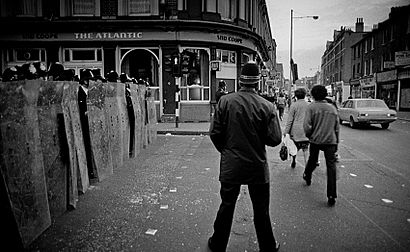Brixton riot (1981) facts for kids
Quick facts for kids 1981 Brixton riot |
|
|---|---|
| Part of the 1981 England riots | |

Police with riot shields form a cordon across Atlantic Road at its junction with Coldharbour Lane, 11 April 1981
|
|
| Date | 10–12 April 1981 |
| Location |
Brixton, South London, England
|
| Methods | Rioting, looting, arson |
| Reported injuries | |
| 279 police officers injured 45 members of the public injured |
|
The Brixton riot was a major event that happened in Brixton, London, in April 1981. It was one of the biggest riots in London's history. This event involved many people and led to damage and injuries. It showed the strong feelings and problems in the area at that time.
Contents
Understanding the 1981 Brixton Riot
Brixton Before the Riot
Before the riot, Brixton in South London was a very poor area. Many people living there faced tough times. There was high unemployment, meaning many people could not find jobs. Housing was often in bad condition. Many black people, especially those from the Caribbean, lived in Brixton. There were also tensions between the community and the police.
How the Riot Started
The riot was not planned. It began on the evening of April 10, 1981. Around 5:15 PM, police stopped a young black boy who was injured. As two police officers took him to a police car on Railton Road, a large crowd gathered. The crowd attacked the police. More police arrived, and the boy was taken to a hospital.
The Night of the Riot
Throughout the night of April 10 and into Saturday, April 11, more police came to Brixton. Crowds of people slowly started to gather. In the early evening, police tried to make some arrests on Atlantic Road. This is when the riot truly began. People started throwing bricks and smashing windows.
More police arrived, and more things were thrown. The police then pulled back, leaving their cars behind. Some police cars were burned. Other cars were also set on fire. People started taking things from shops on streets like Railton Road and Brixton Road. The police eventually returned to the area.
The police closed off the Atlantic-Railton-Mayall area to the public. However, groups of rioting people were in other streets too. Rioters threw bricks, bottles, and homemade fire bombs (called Molotov cocktails). Cars and buildings were burned. Fire engines trying to put out fires were also attacked.
The riot was most intense around 8 PM. Two pubs, schools, and other buildings were burning. About two hours later, the police started to get the area under control. The fire brigade could only return the next morning. By 1 AM, the streets were mostly clear, except for the police. There were attempts to start violence again on April 12. But these were stopped by over 1,000 police officers on the streets.
After the Riot
The riot caused a lot of damage and injuries. Almost 300 police officers were hurt. About 65 members of the public were also injured. Over 100 cars were burned, including 56 police cars. Nearly 150 buildings were damaged, and 30 of them were burned down. Many people were taken into custody.
After the Brixton riot, more riots happened across England. These took place between July 3 and 11 of that year. Riots occurred in places like Handsworth, Southall, Toxteth, and Moss Side. Smaller incidents also happened in other cities.
The Riot in Music
The events of the Brixton riot inspired some famous songs. The musician Eddy Grant wrote the song "Electric Avenue" about the riot. The band The Clash also had a song called "The Guns of Brixton." This song came out before the 1981 riot, but it described the general feeling in Brixton.
Images for kids
See also
 In Spanish: Disturbio de Brixton de 1981 para niños
In Spanish: Disturbio de Brixton de 1981 para niños


